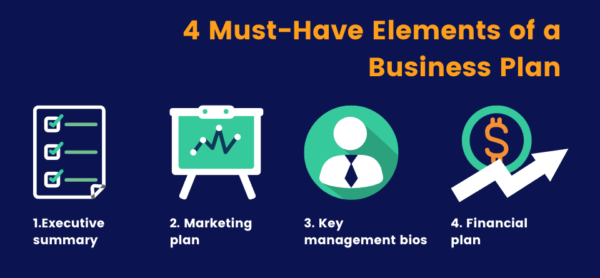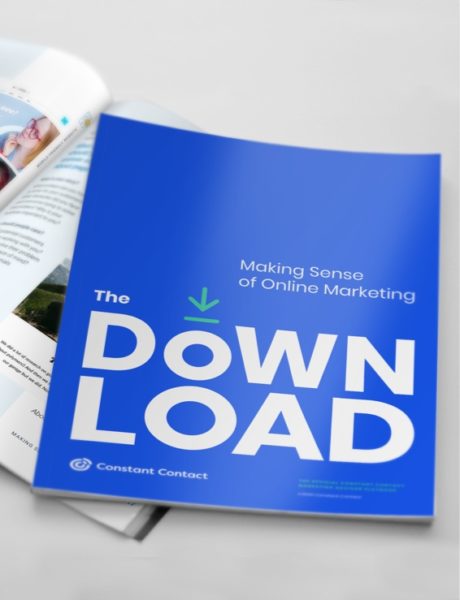
When you apply for a job, you get one shot — one resume and cover letter — to present to a potential employer and hope, out of hundreds of applicants, they choose you to interview. A business plan is really no different.
While a full-length business plan has many components, most small businesses can simplify. By putting your focus on just four simple elements, you can create a basic business plan that will be effective for you and your business.
In this post, I’ll help you understand which components of a business plan are considered the most critical and why, as well as learn what to include in each of these sections.
If you’re feeling a little lost or overwhelmed, stay with me! By the end of this article, you’ll have a clear idea of what to focus on to create a business plan that actually works for you.
A quick look at all the sections of a full-length business plan
While you only really need to focus on the most important components of a business plan, it helps to know what a full-length business plan looks like. So let’s take a quick look at all possible business plan sections before we go deeper into the four most important ones.
A full-length business plan includes the following sections:
- Executive summary
The first and most important section, summarizing everything you hope to accomplish with your business. - Company legal description
Defines your company’s legal status. - Products and services
Lays out the products and/or services you plan to offer to customers and clients. - Marketing plan
Explains your plan for reaching, acquiring, and retaining customers for your business. - Operations plan
Shows that you’ve thought through the logistics of actually operating your company, including hiring staff, shipping, storage, and more. - Organization and management
The organizational structure of your company — what does staffing look like? Who manages which teams? - Bios of key management
Highlights the experience and competence of the key leaders in your company. - Personnel plan
A deeper dive into your plan for hiring and retaining the best staff to manage and run your company. - Intellectual property and other key assets
What are the key assets your company has ownership of? Even if it’s just an idea that you have legal claim to, list it here. - Financial plan
Lays out the cost of everything mentioned in the previous sections, plus your plan for funding to cover those costs. - Appendix
Nitty gritty details that you can reference in other sections of your plan. This will include tables, charts, budgets, and other “hard” figures.
Which business plan sections do you think are the most important for an existing small business in most situations?
If you answered it all depends, you are a smart entrepreneur! It all depends on what you are trying to accomplish and who is your target audience.
That said, most small businesses can focus on just four elements for a basic business plan, which can help you stay focused and keep you from getting overwhelmed.
The 4 must-have elements of a business plan
After having written and reviewed hundreds of business plans, I feel there are four key sections used in almost all situations, and these are augmented by additional sections depending on the circumstances (That’s why we looked at all the sections of a business plan above).

The four most important business plan sections for a basic business plan are:
- Executive summary
- Marketing plan
- Key management bios
- Financial plan
Now, let’s look at each of these key business plan sections in detail.
1. Executive summary
This is one of the shortest components of a business plan, but the one you should spend the most time working on.
Whether your business plan is 5 or 30 pages, an executive summary section must recap all of the material in your plan in only two pages. The reason this section gets so much attention is that it might be the only section the reader looks at when making a decision to go forward or stop.
To paraphrase an old proverb, “You can tell the quality of a business plan from its executive summary.”
The executive summary is the ultimate elevator pitch where you introduce the idea for your business, provide background, talk about approach and results, and convey confidence that you will be successful.
When you get the reader excited about your business idea, they will be inclined to explore it further. In that sense, the executive summary is much more than a summary; it is your call to action.
What goes into your business plan’s executive summary section?
In the first paragraph, the executive summary should include a description of your business and the customer problem being uniquely solved so the reader understands what you are trying to achieve.
The next set of paragraphs — the marketing paragraphs — should include information about the size of the market, sales forecast, demographics of your potential customers and competition, and your competitive advantages.
Next are the operations, staffing, and management paragraphs. These demonstrate your or your management team’s leadership and industry experience, along with a few key details about the location, staffing, and operations of your business.
The financial section of the executive summary should include the projected income and cash generated during the first three years (or next three years) of your business. If you are seeking funding, you should also include a clear statement of how much money is needed to fund the project. And of this sum, show how much you will be investing yourself versus the amount being sought from the funder.
Remember — while the executive summary appears first in the business plan, it should be written last since it is the summary. A business plan is developed from the bottom up, so you need to work out all the details before you can write the summary.
2. Marketing plan
The number one issue for small businesses is reaching new customers. For many business owners, this is the most important section, and much time is devoted to developing it. For without demand, there are no sales.
A marketing plan has three main sections:
- Market analysis
- Competitive analysis
- Specific marketing actions
Market analysis section
There are two main purposes of the market analysis section. First is figuring out how big the market is: You need to know if there will be sufficient customers to buy your product or service so you can generate satisfactory revenue. The second is to describe your potential or ideal customer so you will know how to reach that market when conducting your outreach.
Competitive analysis section
The point of the competitive analysis section is to make sure you understand what you are up against.
This section should list about five competitors and their strengths and weaknesses. Some examples of things to cover when looking at your competitors are:
- Operating hours
- Accessibility
- Pricing
- Return policy
- Marketing budget size (or a rough estimate)
- Brand reputation
- Product delivery policy (is it provided free, at cost, or not at all)
- Complementary products and services
- Buying quantities (which may equate to lower or higher costs).
Specific marketing actions
The specific marketing actions are developed in your marketing action plan, which is used to implement your business idea.
In other words, what are you going to do to drive traffic to your front door — both literally and figuratively? What five marketing steps you will be undertaking? For each of the five marketing steps, note the cost to implement (which, when totaled, becomes your marketing budget), if the items can be completed by you alone or whether you will need assistance, and the sales expectations (which when added together, become the sales forecast).
The marketing budget and sales forecast will be used in the financial forecasts in your financial plan section of your business plan.

Not sure where to start with marketing? That’s why we created The Download.
The Download is the ultimate practical, step-by-step guide to online marketing. In this free guide, we’ll show you how people find you online and how to set yourself up for success to meet your business or nonprofit goals.
3. Key management bios
With a limited track record and usually few assets, the success of a small business is typically a bet on the owner. So this section must convince readers that the bet is a good one.
Include a one-page bio on each of the key people involved in your business. Write these bios in a style that demonstrates you’ve “been there, done that” and know how to do it again.
You want to demonstrate that you have the technical chops for the business as well as the leadership skills. Where there might be experience or skills gaps, mention how you plan to add others to the team to provide this expertise.
4. Financial plan
One of the final elements in your business plan is the financial statements. While the financial plan is a very important section, it’s appropriate for it to come last, because if the executive summary is a discussion of all that is to follow, the financial section is a recap of all that precedes it.
The products and services, marketing, operations and personnel sections demonstrate that the business idea is feasible, but it’s the financial section that demonstrates it is viable.
For many, tackling this section last is fine because it’s the one plan element that most entrepreneurs dread. They frequently feel like they have hit a wall when it comes to writing this section, and they blame it for holding up their business plan. Typically this is because they don’t understand it, are afraid of it, or have made it unnecessarily difficult because they haven’t carefully completed the rest of the business plan.
Don’t let this happen to you. If you feel stuck, seek guidance from a SCORE mentor or other free services as mentioned here.
Financial statements are charts with lots of numbers and few words describing what they are all about. Therefore, it is advisable to have an introductory page in your financial plan explaining in plain English the key assumptions and how each one was determined.
If you can convince the reader about the reasonableness of the assumptions, then the sale has already been made when they read the financial statements.
Key lessons on the 4 key components of a business plan
There you have it! Hopefully, by now you’re feeling better about what actually matters when it comes to outlining your own business plan.
Let’s revisit the top lessons we went over in this article:
- The executive summary, marketing plan, key management bios, and financial plan business plan sections are critical and should be included in all business plans.
- Additional sections can be added to these four when targeting specific purposes and audiences.
- It’s imperative to get readers excited about your business idea from the outset in the executive summary, or they may not read any further.
Next steps for creating your own business plan
- Choose which sections you need in your business plan. Be sure to include the four most important elements, and add any others from the beginning of this article that you think you might need.
- Sketch or outline what you will include in each business plan section
- Gather the information and data that support your business plan
- Use this info to fill out each section of your business plan
- Review each component of your business plan with trusted mentor, colleague, or friend
This is the second in a four-part series by Hal Shelton, SCORE small business mentor and author of The Secrets to Writing a Successful Business Plan. This post revealed four must-have sections of every business plan. Next, we look at when is the best time to revamp your business plan.





